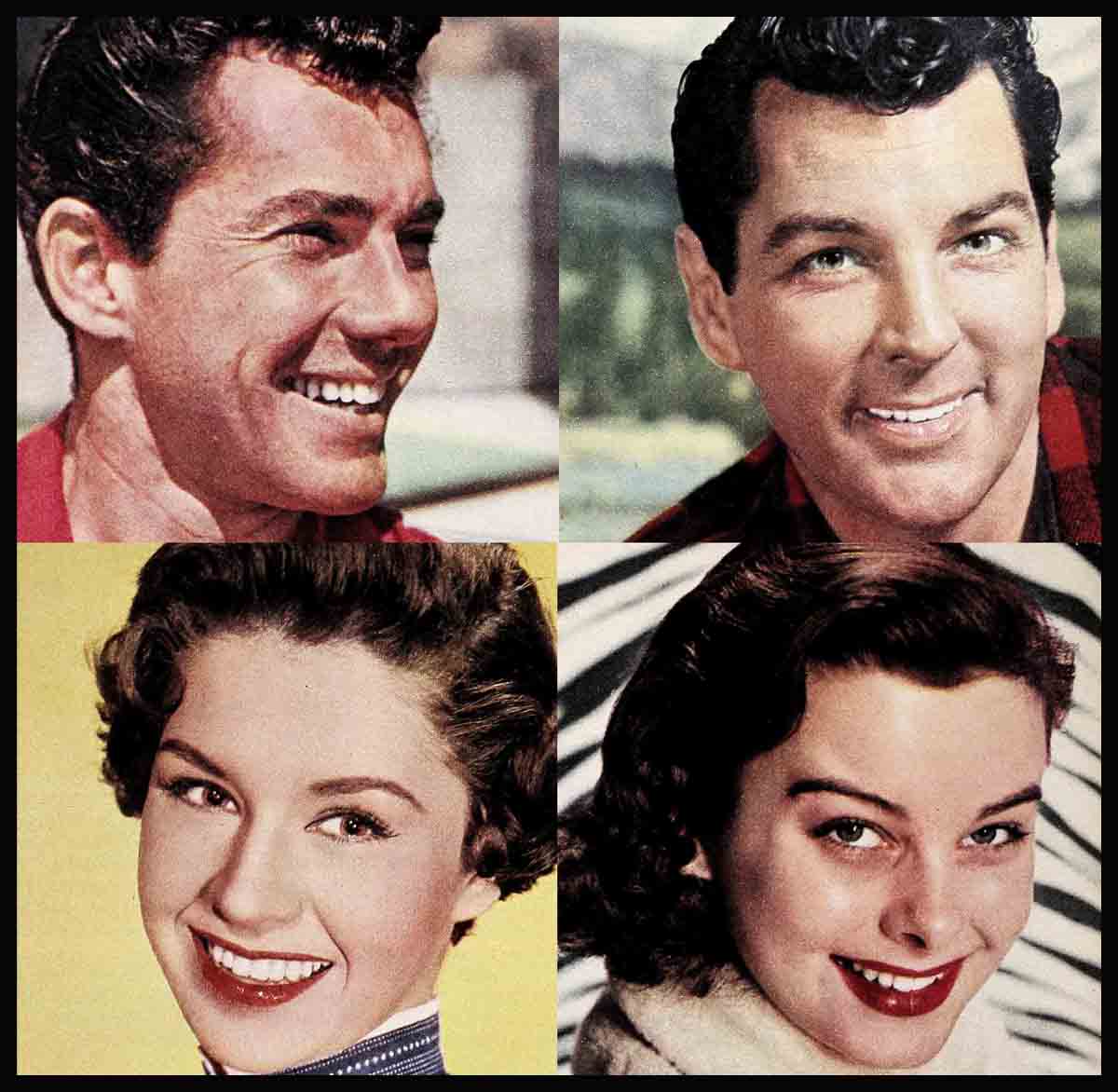
You Chose These Stars
Richard Allan had finally managed to wangle a spot in a Broadway show, “The Red Mill.” And he might have been on Broadway still, if a friend of his, a comedienne, hadn’t told him she was driving to the West Coast and invited him to come along. “Honey,” she had said, “you belong in Hollywood.” For a long time, it seemed that she was the only one who thought so. But Dick stayed anyway—and he’s glad he did.
They’ve come to Hollywood from many places and in many ways—these young stars you’ve chosen. And they can all tell you that getting there is only the first punch on the ticket to film fame. Today’s stars of tomorrow face probably the toughest times in movie history. Studio contract lists are being slashed while the industry pauses to take stock of the long-range effects of the various “scope” and 3-D developments.
These are times that call for the most in talent, the luckiest in breaks and the bravest of hearts. For whatever size and shape pictures eventually take, the dimensions demanded for stardom are more all-enscoping than ever. And the competition is all out of proportion to the number of stars there is room for.
These winners you’ve chosen share one thing—the determination to succeed. But their stories and backgrounds are startlingly‘ varied, their homes widely scattered throughout a broad swathe of the world.
Nineteen-year-old Audrey Dalton was studying to be an actress at the Royal Academy in London when a Paramount scout spotted her. “I was playing a middle-aged woman in a play,” she recalls with amusement. But the scout saw her fresh beauty through the make-up. They tested her for “The Girls of Pleasure Island” at once and flew her to Hollywood.
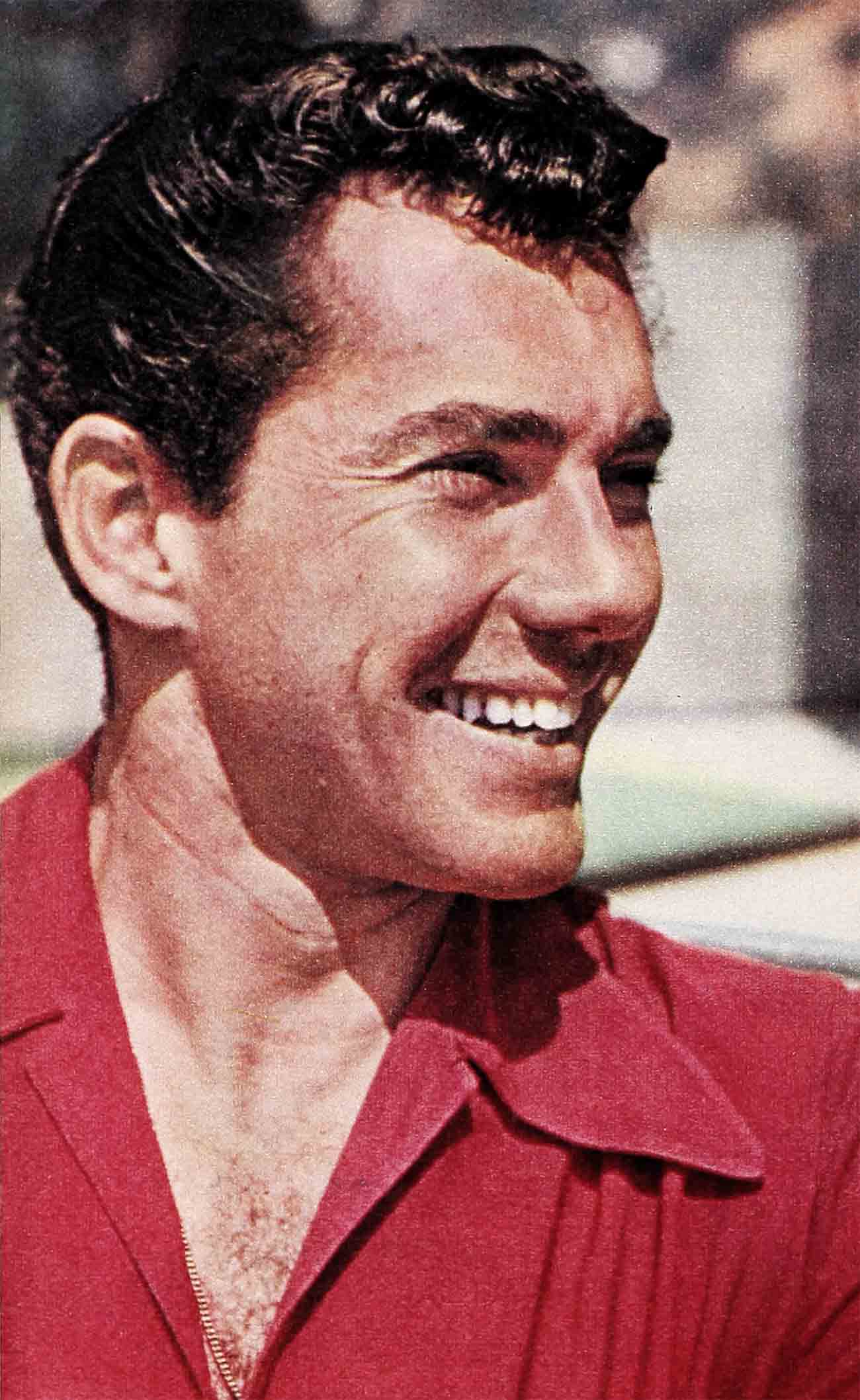
He might still be struggling on “The Great White Way”—if he hadn’t taken advantage of a free ride to Hollywood
Although her home’s in Hawthorne, California, Betta St. John had to score in “South Pacific” in London before she was brought back and signed. Bobby Van danced his way into town. And the South American romantic, Carlos Thompson, who had intended to become a writer, was discovered at a foreign film festival by Yvonne De Carlo. She liked what she saw and encouraged him to come to California and be her co-star.
Maggie McNamara was discovered on a Chicago stage when the moon was very blue. Italian Marisa Pavan was spotted by a Hollywood producer. who saw her one day with her twin sister, Pier Angeli, and felt she was just right for the part of the fresh, young French girl in “What Price Glory.”
Chuck Connors was playing baseball with the Los Angeles Angels when he belted a talent home run over the fence into Hollywood. Kathleen Crowley won a beauty contest as “Miss Egg Harbor,” went on to become “Miss New Jersey,” and wound up with a scholarship to the American Academy of Dramatic Art.
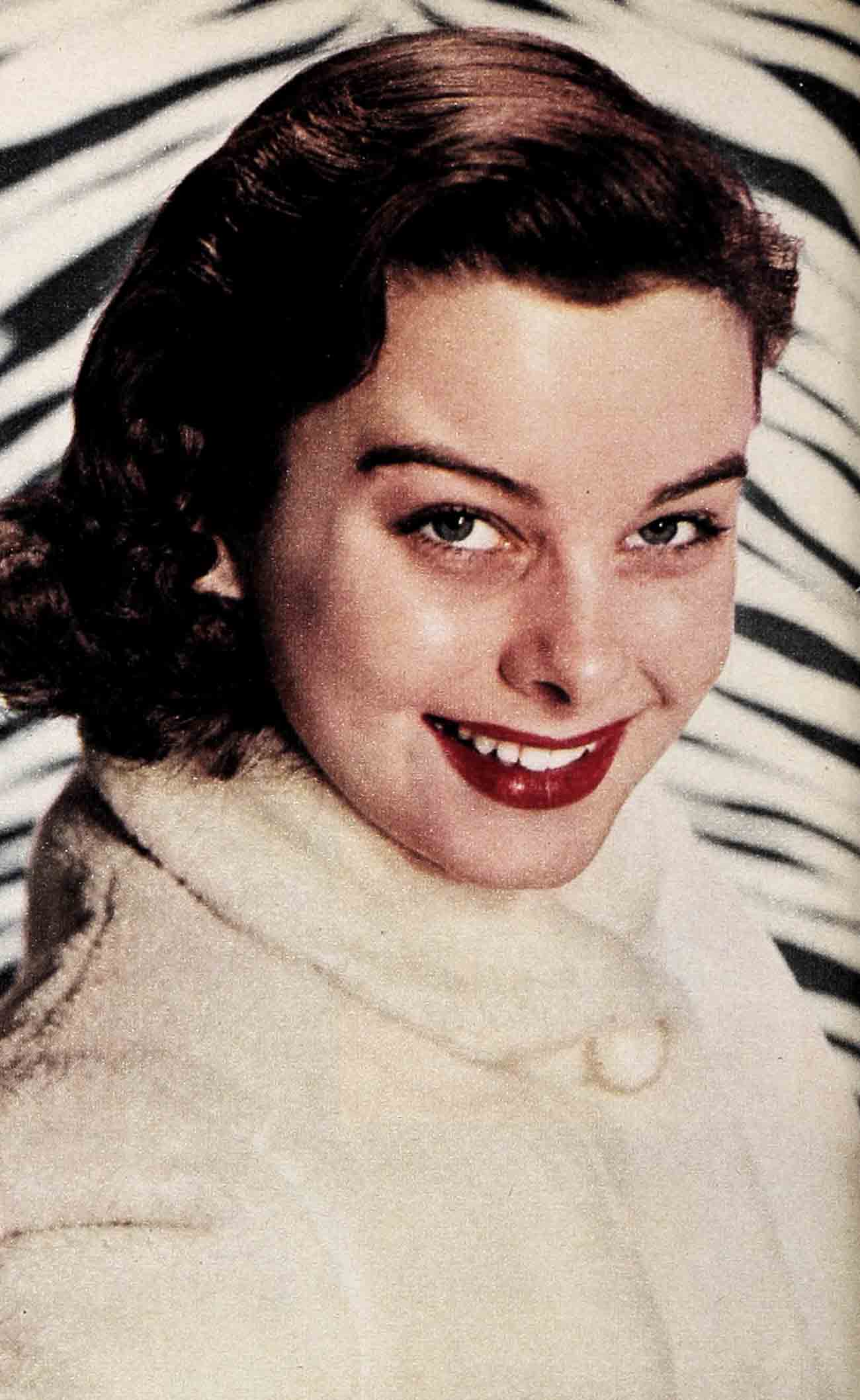
She studied acting in London and dreamed of an American career in films. But she didn’t expect her dream to come true so soon
And some had spent a long time—their whole lives—under the Kliegswept skies before they got their chance. Byron Palmer, whose father is publisher of the “Hollywood Citizen News,” had to go to Broadway before he could snag any star space in his own home town—and he’s still working hard to earn space in his father’s paper.
Charlotte Austin, lovely daughter of Gene Austin, had been brought up in the atmosphere of films. But it had never occurred to her to make herself a part of movies. Not until an agent saw her when she was a bridesmaid at her best friend’s wedding, and told her she ought to be in pictures. She’s horrified now at what she almost missed. “I argued with him for forty-five minutes,” says she, “to try to convince him how wrong he was.”
Joanne Gilbert, the daughter of song-writer Ray Gilbert, stepped into the spotlight at Mocambo on the Sunset strip to make her debut as a singer. Her sexy voice and arresting ensemble—plunging white blouse, black shorts, opera-length hose—captivated her neighbors and won her a Paramount contract.
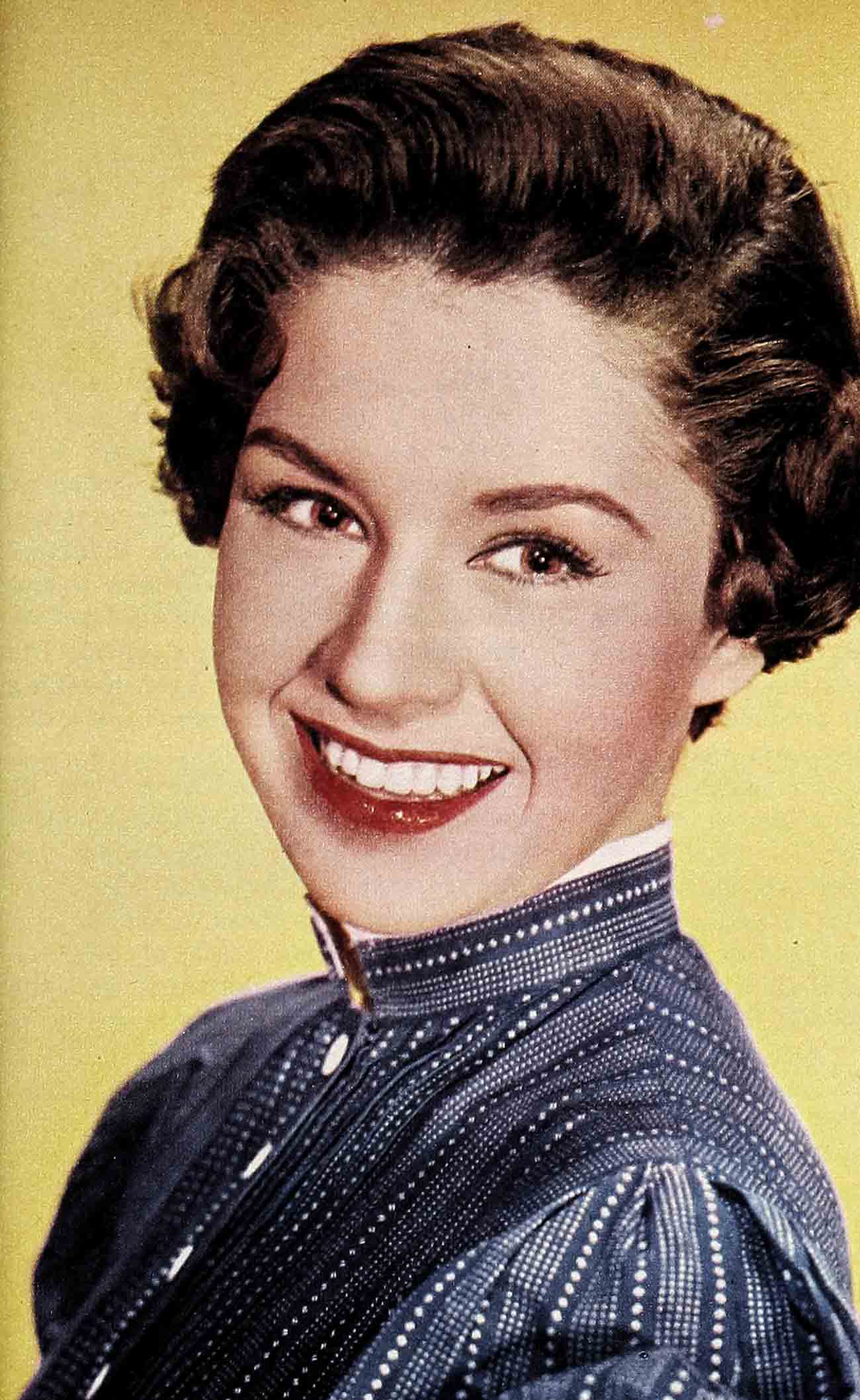
Her saga of success is one more proof of TV as a testing ground—she was in “Date with Judy” for thirty-nine week
West Los Angeles was the magic spot for Race Gentry. He was working in a service station when agent Henry Willson drove in for some gas, looked at him, and asked if he’d like a movie career. “I thought he was kidding,” says Race. “But I looked into it and found he was a big agent. He got me the part of Rock Hudson’s son in “The Lawless Breed.’ And I keep thanking my lucky star that he doesn’t use a different brand of gas.”
What a break for Race that he doesn’t! And what a break for all these handsome, talented young people that they happened to be where they were when opportunity chose to knock.
But the biggest break of them all has come from the faith that you—the readers of Photoplay—have shown by casting your votes for them.
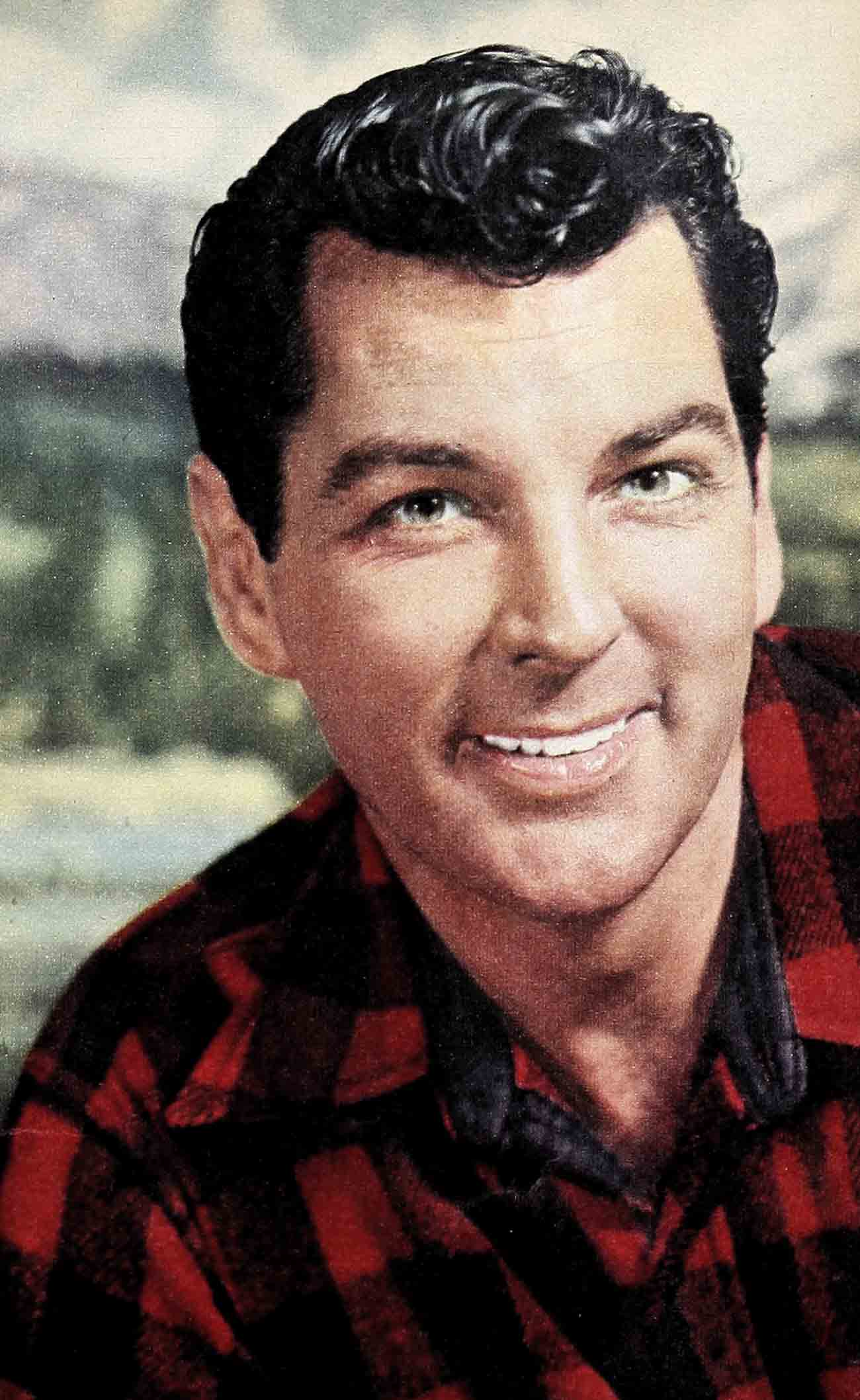
Hollywood-born, he had to make a name for himself on Broadway before he could get back to making a name in his own home town
“You feel so humble and grateful,” says Richard Allan movingly, “to the people, whoever they are, wherever they are, who voted for you. I only hope that I’ll be able to say thanks by becoming the star they think I can be.” And he pauses. “Of all the things, this is the greatest thing that’s happened . . .”
And a great deal has happened to Twentieth’s triple-threat, singer-actor-dancer, Dick Allan since the boy with the dark curly hair and blue eyes first decided to make his mark. “Back home on the farm in Jacksonville, Illinois,” he recalls, “we used to put on shows and make the neighbors pay a penny to come and see us. And I used to haunt the local movie house. I would sit through Fred Astaire’s pictures over and over again, watch his feet and then go home and try to work out the steps.”
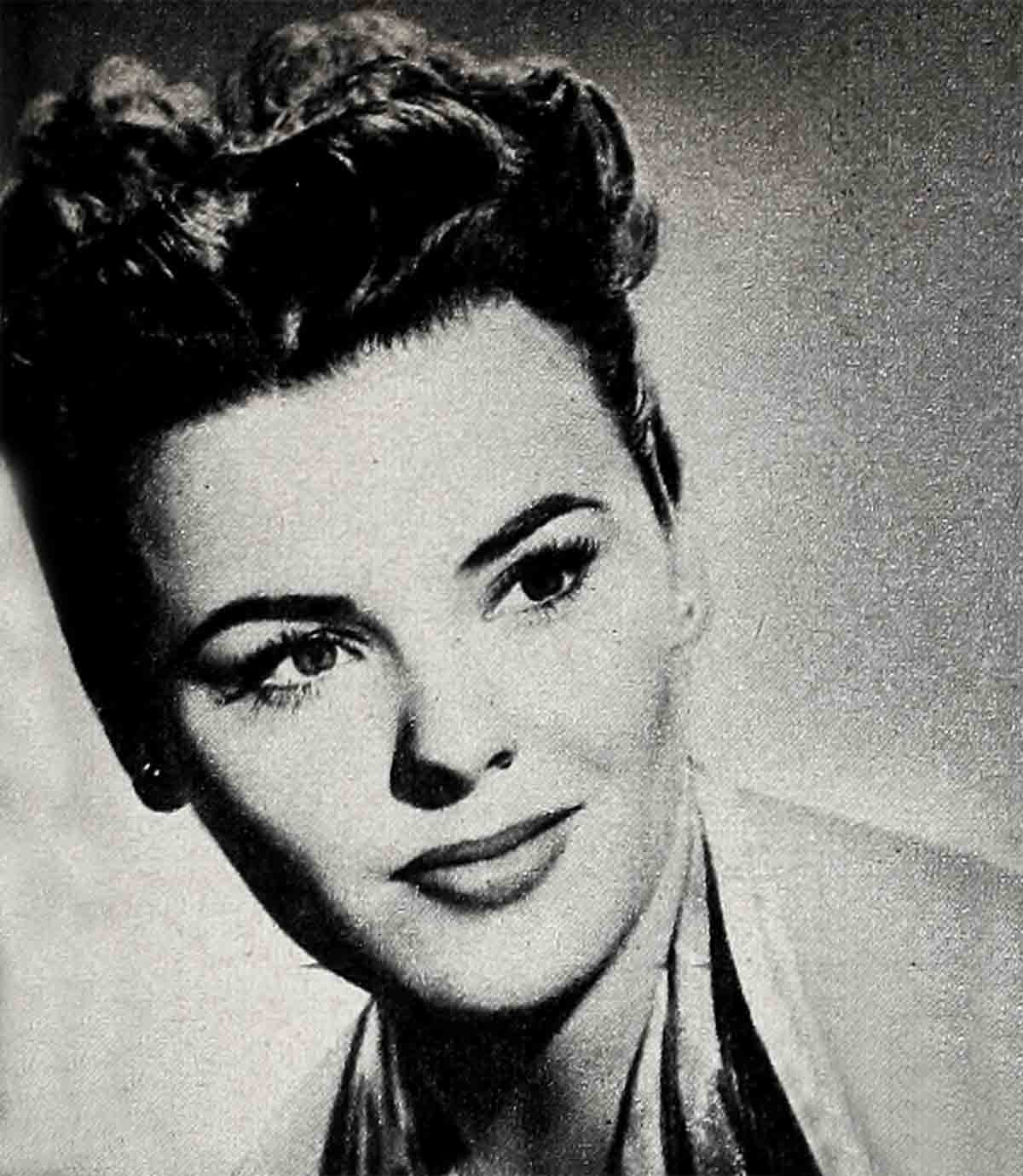
She knew her first fame as “Miss New Jersey.” Now she’s in “Sabre Jet”
Years later, after working for his dancing lessons, working his way through the University of Illinois as a singing waiter in a sorority house, working for Uncle Sam in the quartermaster’s laundry battalion, and working briefly on Broadway, he hitched that ride west with Odette Myrtle—and worked with Astaire in Paramount’s “Let’s Dance.”
But there were many steps in between. “You could live on twenty-five dollars a week then—if you had friends. And I was lucky that I did. I worked as secretary for Gene Loring at the American School of the Dance, for my dancing lessons. I charged my singing lessons—the coach believed in me. So did my drama coach, fortunately. And Odette and her husband saw that I didn’t go hungry.”

You saw him in “Sombrero,” loved him, and gave him a big hand along the way
Dick’s resourcefulness and versatility began paying off before too long. Gene Kelly called the dance studio one day, said they were auditioning dancers at M-G-M for “Take Me Out to the Ball Game.” As Loring’s secretary, Dick took the call, and said he would announce the auditions at school. “Why don’t you go yourself?” Loring asked. He did, and he was chosen. “As it turned out, they didn’t use the number, but as a result of this, I got my guild card.”
He blessed his stretch as a lifeguard back home in Jacksonville when a call came for an Esther Williams picture. “They wanted dancers who could swim,” he says. “I had a solo number with Esther. I danced out on the diving board and did a twenty-four foot leap into the water. I got sinus trouble—and the scene was cut out.

One look at him in “Small Town Girl,” and you tagged him a sure-fire winner
“Then Paramount wanted an actor who could row a boat to double in ‘A Place in the Sun.’ They got 9,000 feet of film of me rowing a boat—I got a stiff shoulder.”
For Dick, the last three years at Twentieth Century-Fox have brought invaluable experience. His biggest thrill? “I think working with Susan Hayward in ‘With a Song in My Heart.’ ” His toughest moment? The scene in “Niagara” in which, as Marilyn Monroe’s lover, he plans a murder.
Today Dick Allan is concentrating on his voice. His coach, Minneletha White, who has coached so many of Hollywood’s famous, describes it as “a tenor with meat,” equally effective at crooning or really belting them out. She says, “He’s the greatest combination of talent in the business.”
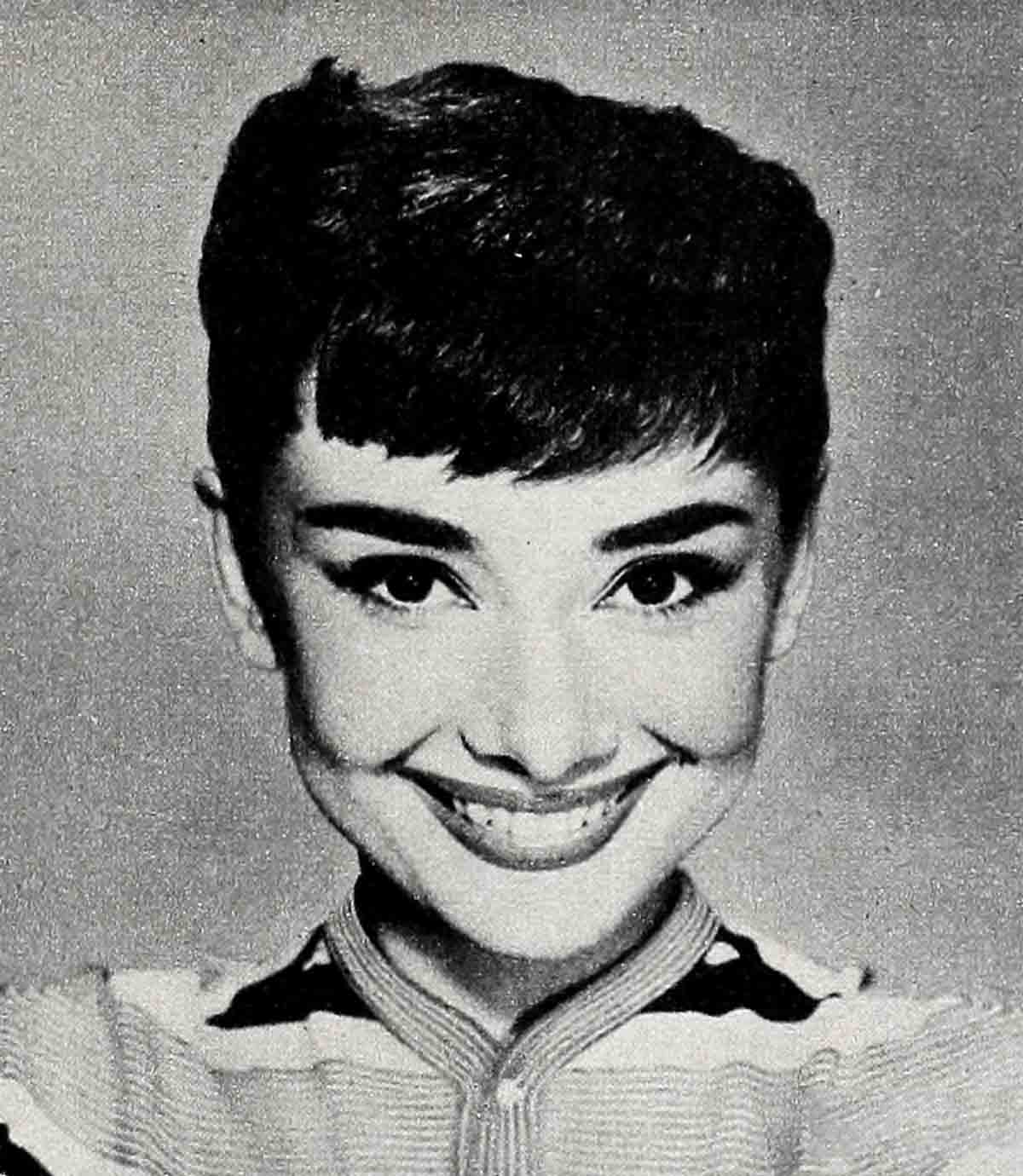
Already an international rave, there’ll be no holding this foreign beauty down
Unmarried, Dick prefers well-groomed girls with the “scrubbed” look. “When I worked as a waiter in the sorority house, I saw girls coming down to breakfast with their hair in curlers and no make-up. And that’s all right. I don’t look like a rose myself in the morning. But their faces were washed and shiny—and they looked good to me.” But as for matrimony, “I just don’t think you can work at a career as hard as I have to work at mine now and have a successful marriage too.”
With that, Ireland’s shy beauty, Audrey Dalton, wouldn’t agree. Newly married, Audrey has stars in her eyes as to her future. Neither her growing career at Paramount, nor the fact that she was in America on a working permit, could discourage her from marrying blond, clean-cut Jim Brown not long after they met. “And marriage doesn’t change your status in the country,” Audrey explains, “except to get you a visitor’s visa. Mine will be up in March.”
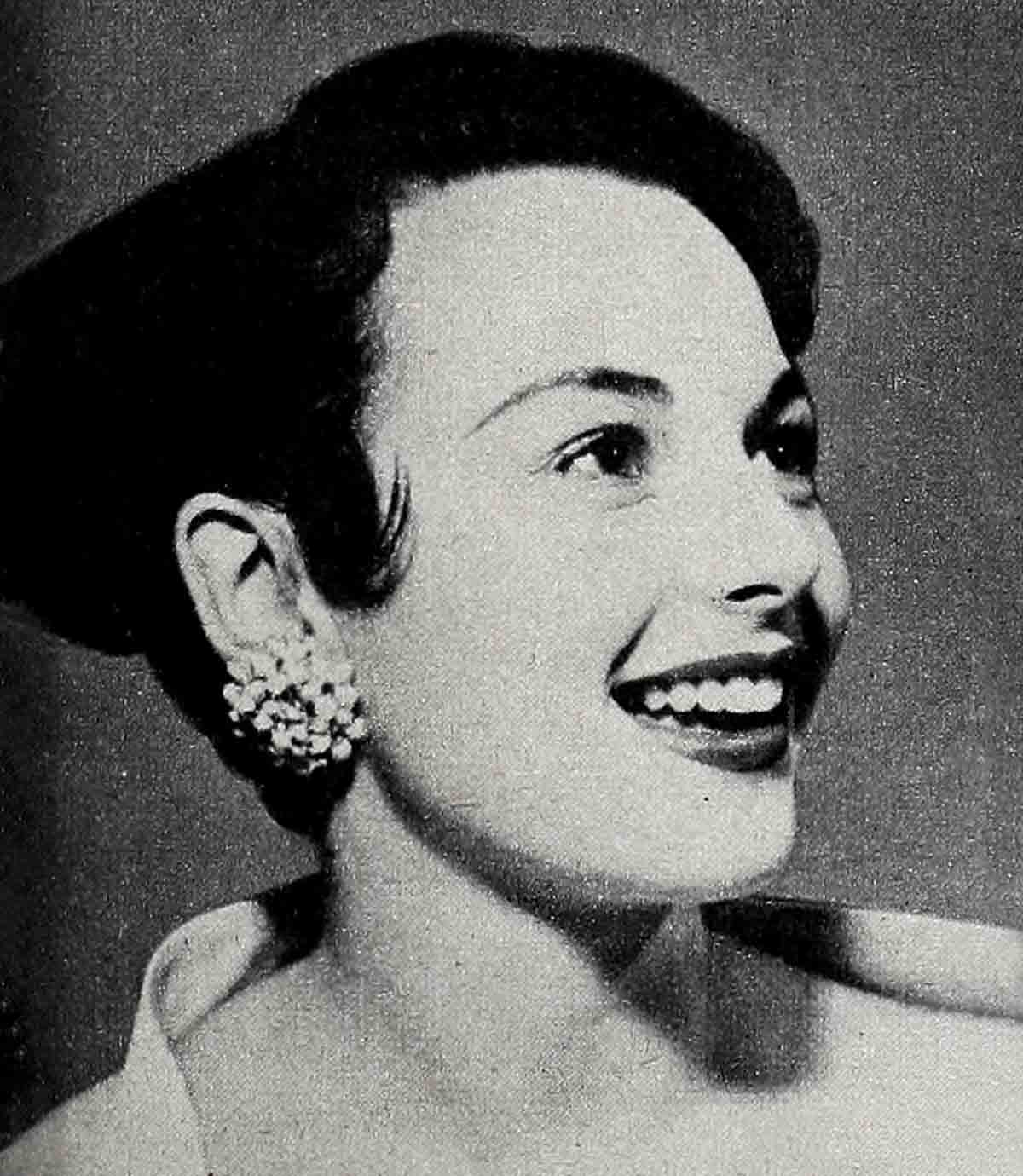
Wait till you see her in “How to Marry a Millionaire.” Talent and beauty, plus
However, with the faith of the Irish—and those so in love—she believes it will work out. She admits she was impressed by her husband first “I think, because he did most of the talking, and let me sit quietly. American men like to talk,” she twinkles, with a hint that the Blarney Stone may be in the wrong place.
Working in “Casanova’s Big Night” with Bob Hope, who is also somewhat talkative, was thus a double pleasure. “When I first came, he called me ‘A little Lipton tea bag.’ I thought he would be making wisecracks all during the picture, but he’s been very sweet,” she said. “My difficulty is keeping a straight face working in a scene with him.”

The latest threat from south of the border, most anything can happen with him
She’s a real Irish beauty, Audrey Dalton. “Nineteen and a half,” years old she tells you. Although her father is a distributor for Sam Goldwyn in London, Audrey had no aspirations toward movies and was studying for the theatre when Paramount discovered her and brought her to Hollywood. She is both touched and surprised to find herself so warmly welcomed by Photoplay readers. “I never thought anything like this would happen,” she says.
Our men? “Well, men are rather like men the world over,” she smiles. “American men have a wonderful sense of humor and it’s easy to make small-talk with them. They like to talk a lot.” And that’s fine, because Audrey’s a girl who loves to listen.
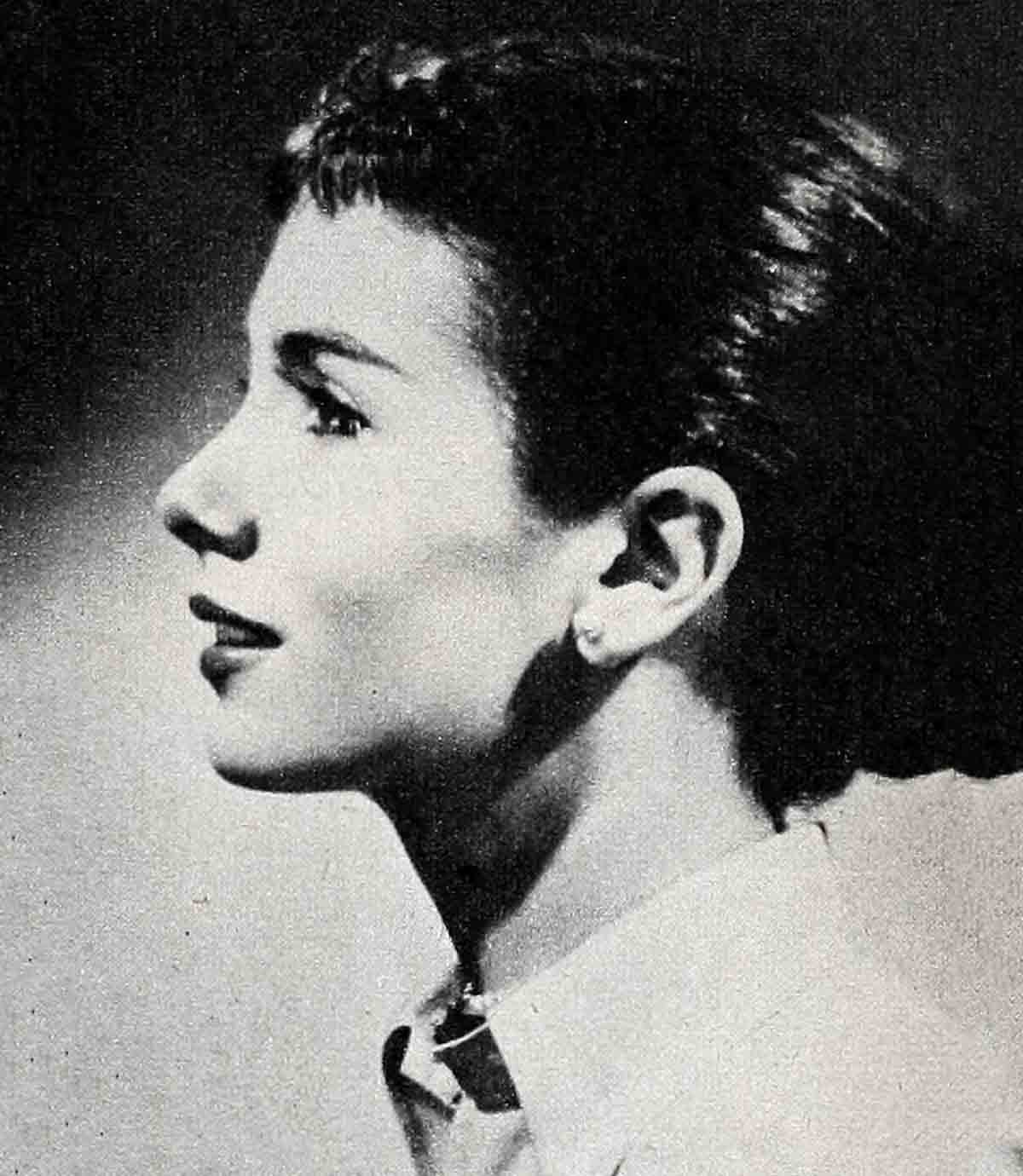
Her debut was in “The Moon Is Blue”—and that can’t do her any harm!
Easy to listen to—and to look at—is Hollywood’s newest heart-breaker, Byron Palmer, with his black curly hair, laughing blue eyes, dashing charm, and, temporarily, a dashing moustache. “That’s for ‘The Man in the Attic,’ in which I play a Scotland Yard inspector,” he explains.
It’s been a hard climb for Byron, via radio, musical comedy, summer stock, and Broadway, to today’s Twentieth Century-Fox success. Take his word for it. “It’s even tougher when Hollywood’s your home town. You can live in the shadows of the studios forever and they can’t see you.”
That Byron’s dad is Judge Harlan Palmer, influential citizen, and publisher of the Hollywood Citizen News, opened no doors for him. On the contrary “From the beginning,” says Byron, “my dad and I made a pact that I would ask no help from him. And I wanted it that way too.”
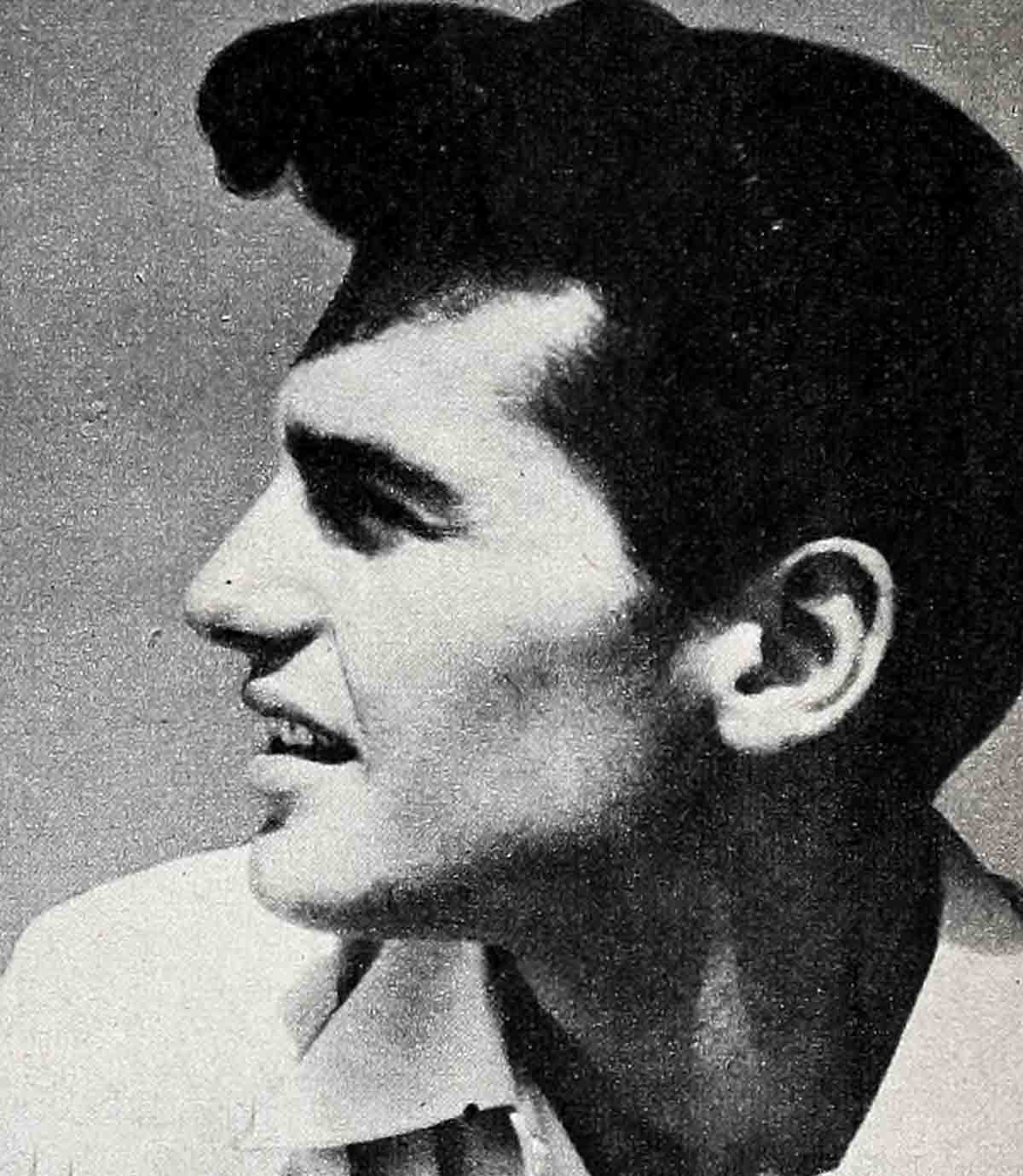
He had just a bit in “The Lawless Breed” and you clamored for more
When he was mentioned in Ed Sullivan’s syndicated column for his performance in the Broadway hit, “Where’s Charley?” his dad had his name deleted, lest anybody think he was publicizing his own son. That made it mean all the more to Byron, when as they were leaving the theatre, following the preview of “Tonight We Sing,” his dad said, “You were good, boy, very good.” He smiles when he says, “My mother voted for me in Photoplay’s contest, I’m sure.”
This handsome eligible is attracted to girls with “Sincerity, a sense of humor, and a zest for living. That’s so important.” And the little lady nearest his heart, is his daughter, Linda Lou, seven, of whom he says, “She’s the light of my life, with zest to spare.” Almost every Sunday you’ll find them aboard a roller coaster and “all the other rides I can fit into.”
Divorced, Byron’s batching in a tiny “continental type cottage” high up in Laurel Canyon “right on top of the lights.” This, for Byron Palmer is a welcome and a well-earned view. “Looking out over this tremendous sprawling city,” he says, “you realize how insignificant you are.”
That she’s “any part of it at all” frankly amazes nineteen-year-old Pat Crowley, despite the raves for her performance in Paramount’s “Forever Female.” “I didn’t think I’d try pictures for a long time,” she says. “I was working in television and summer stock, getting more experience. Movies are the dream of every girl, of course—your aim—but I didn’t think I was ready. I didn’t want to come out and be a big flop.”
The daughter of a former Oliphant, Pennsylvania, coal-mining foreman, Pat could be any college girl, with her freshness, her zest, her interested hazel eyes, and her young, simple hair-do.
She made her first appearance on Broadway at thirteen—“A walk-on in the first act. I had to be home by nine—” when her famous musical-comedy star sister, Ann, was doing the second lead in “Carousel.” But Pat really fell in love with acting later on, in summer stock. “There was such a warm feeling of fellowship,” she puts it, “with everybody kind and helping everybody else.”
Her first Broadway lead was in “Southern Exposure,” in the part of “a very sexy belle, over-exposed. In one scene I just wore a slip. My mother was so embarrassed.”
Pat had always anticipated the excitement of an opening night “with tons of flowers and crowds rushing backstage to congratulate you, but just my family, the three of them, filed slowly back to my dressing room. They wanted to ship me off to Siberia that night before the reviews came out, but mine were real nice.” The play was a flop, but Pat won the Theatre World Award, although, as she says, “My father will never understand how. He still thinks I was pretty horrible.”
She was a successful television actress with some 500 shows behind her, when Paramount’s New York office called about the reading for “Forever Female.” “It was just a routine call. I didn’t care too much either way—and I didn’t think I had a chance anyway. Luckily nobody told me much about the picture. If I’d known that Bill Holden was going to be in it, I would have just died, exclamation point.”
She modestly dismisses the fact that she got the part with, “I was just the type I guess. I’m a lucky girl and I know it.” But despite the raves for her performance, Pat was a great disappointment to herself at the preview. “I loved the picture. I thought Ginger Rogers was wonderful, but I was just kind of nothing.”
Describing herself as a “fiend for clothes,” she prefers black and white, but bows often to pink because says she, “Pink is the color men love. Pink and high heels, it seems. I wear high heels too and they kill me, but I’ll suffer. Men? I think they’re all dolls, exclamation point.”
And that sums up the feminine reaction to M-G-M’s handsome Carlos Thompson, judging by what you hear at home, and by the international sighs which followed him around Europe during the production of “The Flame and the Flesh,” in which he co-stars with Lana Turner and Pier Angeli. Producer Joe Pasternak, confident that Carlos will take his place among the great leading men, reports the gals’ eyes followed him from London to Rome. “They were always asking, ‘Who is he?’”
He’s Juan Carlos Mundanschaffter, son of a South American newspaper man. He was torn between writing and acting, when Yvonne De Carlo (whose name as well as Piper Laurie’s has been linked romantically with his) discovered him at a film festival and persuaded him he belonged in Hollywood.
Although it’s her home town, it took some persuading too, to convince nineteen-year-old Charlotte Austin that she belonged in motion pictures. But Charlotte convinced all of Hollywood when she substituted for Marilyn Monroe in a test scene for “How to Marry a Millionaire,” filmed to demonstrate CinemaScope. After the showing, producers, directors and exhibitors were all asking each other, “Who is that girl?”
And although “that girl” grew up under their creative noses, with no movie aspirations, she admits she helped finance the Hollywood run of her first picture, “Rainbow Round My Shoulder,” when it played the Pantages Theatre. “Imagine paying to see it four times,” she laughs. “But it was like watching somebody else.”
Her father is very happy and proud. “He’s never pushed me, but I think he always knew I would wind up in the business some day,” she says, and with all the big plans Twentieth has for Charlotte, Hollywood is her blue heaven today.
It’s heaven now too for nineteen-year-old, dark Race Gentry—and strictly from out of the blue. Because agent Henry Willson and Director Raoul Walsh thought he looked like Rock Hudson, John Papira, son of an Italian-born jewelry manufacturer, finds himself in motion pictures today. The fabulous fan mail which followed his initial screen role, and the small picture of Race which appeared: subsequently in Photoplay, resulted in a longterm-contract at Universal-International. Letters palpitated in from Spain, England, Holland, Italy—and all over America. As one girl wrote, “We think you’re calm, cool—and wow!” Race still can’t understand it. “I didn’t think I’d get any mail at all.” But the letters kept coming, and they’re still coming.
As friendly and down-to-earth as he is good-looking, Race is single and star-bound. “I haven’t thought about getting married—guys really don’t, I guess,” he grins. He’s just finished a small part in “Fort Laramie,” with John Payne, and his studio evidently has big plans for a Western build-up a la those given Tony Curtis and Rock Hudson, because they instructed him recently, “Let your hair grow.”
Pretty Kathleen Crowley blesses her romantic role in a Western, “The Silver Whip,” with Dale Robertson, Bob Wagner, and Rory Calhoun, for introducing her to the fans. “I didn’t think I’d have a chance in this contest. I have such a lump in my throat. I can’t tell you. It means so much—” And she’s sure it means a lot to those gathered around the pot-belly stove in the general store in Green Bank, New Jersey, too. “They have such faith in me, the people back home,” Kathleen says mistily. Certainly the good news couldn’t have come at a more opportunte time, for she was one of 1,000 people recently dropped by Twentieth Century-Fox because so few pictures were being made.
“It was quite a blow, but I’ve had worse blows than that. I really had it in New York. Whenever it’s tough here, all I have to do is just remember the days I lived on bouillon cubes and grapefruit there.” Since she’s been free-lancing, Kathleen’s scored in “Sabre Jet,” done five television films, is set for the romantic lead in Preston Foster’s TV series, “Water Front,” and now knows she has Photoplay’s readers pitching for her too. “When you want to badly enough, you’ll get there,” she says.
And this, Rick Jason, who was so impressive as Cyd Charisse’s lover in M-G-M’s “Sombrero,” could echo. Born in the “silver spoon set,” Rick turned down an easy berth on Wall Street to work his way as an actor. While attending the American Academy of Dramatic Art and “making the rounds,” he washed dishes, worked as a hotel clerk, and as a stock boy at Macy’s department store. He won raves for his performance in “Now I Lay Me Down to Sleep” starring Fredric March on Broadway, and after months of inactivity in Hollywood, won the fans in “Sombrero.” Whatever the challenge of the future, Rick has no regrets about foregoing the sanctuary of the silver spoon. “It was the best thing that ever happened to me. To learn about people—and how to get along in the world—and the value of a buck.”
Learning about American people, the warmth of the fans’ reception, has touched Hollywood’s newest Cinderella star, Brussels-born Audrey Hepburn, so royally welcomed after “Roman Holiday.” Tall, willowy, exotic-eyed, with an unusual gamin type of beauty, Audrey’s a little over-whelmed by it all. Just arrived back in Hollywood for “Sabrina Fair,” Audrey had been out looking for an apartment all day, when she stopped by a public phone booth and called her agent at M.C.A. on some routine business. He told her then that she’d been chosen by the readers of Photoplay. All he heard was a happy husky throaty squeal at the other end of the line.
“I’m simply delighted,” she said when she regained her speech. The acclamation, the fans, the photographers flashing at her, the microphones thrust out to her—“all this is a tremendous responsibility,” she says. “I’ll have to work very hard as an actress to live up to it.”
That happy surprise is duplicated by little Irish Maggie McNamara, who heard the good news when she returned from Rome and the location of “We Believe in Love,” her first starrer under her new Twentieth Century-Fox contract. She was a little amazed that she was chosen on the merits of just one picture, “The Moon Is Blue,”—or perhaps on its demerits, depending on the point of view.
“To think—my first picture banned . . . this is very flattering!” Maggie says gleefully. “Although I don’t know why. I was under the impression that I was being very demure and sweet through the whole thing. After all, nothing happened. She only talked. And talked. And talked—”
As cute as she has been controversial, Maggie McNamara is five-foot-two and size seven, with dark hair caught up in a way she describes as “I just boop it up on my head,” and Irish blue eyes with the longest eyelashes ever. Married to David Swift, famous in his own right as the writer of television’s successful “Mr. Peepers” show, they live in an apartment near Twentieth Century-Fox studio. Her contract allows her to do a play after two years, and she probably will. “I love California—and the climate is better for me,” she says, “but I like the excitement and challenge of New York too. An actress needs the testing of the stage.”
And New York can test you thoroughly as many of today’s winners, including Bobby Van, Ben Cooper, and Joan Vohs, can well affirm. Bobby Van, son of a New York choreographer, fronted his own band, danced, sang, acted. When he made a hit on Broadway in “Red, White, and Blue,” he was signed by M-G-M. He was immediately teamed with Jane Powell and Debbie Reynolds, and his production numbers are being widely acclaimed in “Kiss Me Kate.” Lauded as the “second Ray Bolger,” Bobby’s quick to say, “There’s only one Bolger. Who needs another?”
At twenty, Long Island’s Ben Cooper is a veteran of Broadway with three years’ duty in “Life with Father,” some 3,000 radio shows and 750 live TV shows to his credit. Today, he’s zooming to stardom at Republic studio, where he’s slated for an important role in Joan Crawford’s “Johnny Guitar.” At the moment, Ben’s working with John Derek in “Red Horizon,” for which he perfected a lightning draw. Also, when pressed, he can favor with a few slow chords on the guitar. “I’m the heavy —that’s what these are for,” he explains, of the sprouting sideburns. “I like playing a young heavy. I don’t want to play ‘the boy next door.’” Thrilled about being a winner, he says, “I’d like to meet every person who voted for me.”
So would lovely blonde Joan Vohs, also from Long Island. “I’ve watched the contest ever since I’ve been out here. I thought maybe some day I might get in. And I was so hoping I would win,” says Joan. Acclaimed Hollywood’s first “Three-D” girl, when she starred in “Fort Ti,” she has all the dimensions for stardom.
At sixteen she was the youngest Rockette in the Roxy line, she did a specialty dance in “Oklahoma,” she was in “Follow the Girls,” and her performance in “Parlor Story,” with Walter Abel, got her a Warner Brothers contract. They wired her to rush to the coast for an important part in a picture. Cancelling a farewell party, Joan loaded her mother and sister and cocker spaniel into the car and headed West. But the part didn’t materialize.
“I got here just when the studio shut down and they began dropping people. Big names too. I was pretty heartbroken. Dad was planning on joining us out here when I got going. I’m still trying to get us all together again. I wouldn’t quit after I got dropped. I got kind of determined.”
Determined too, was Salt Lake City’s young dynamic Keith Larsen, today the fair-haired boy at Allied Artists, the star of “Son of Belle Starr,” “War Paint,” and now co-starring with Sterling Hayden in “Arrow in the Dust.” All this in addition to starring in his own CBS television show, “The Hunter Series.” But his was quite an obstacle course. After a wearying eighteen months recuperating from war wounds—“I got it in the Aleutians”—came more months equally wearying, just missing the part or the contract in Hollywood. Finally Keith bought a one-way-ticket to Europe, checked in on the Left Bank in Paris—“I had to learn French fast—I only had $75—” got his start in films there. Eventually he connected with “the greatest guy in the world,” Producer Walter Mirisch, and an Allied Artists contract. His best performance off-screen is persuading New York actress Suzanne Ta Fel (they met on his TV show) to forsake showbusiness and think only of him. “It’s such a tough thing for girls. Don’t you think fifty per cent of them are only working because they haven’t found the right guy?” Keith grins.
Certainly, dark-haired hazel-eyed, sexy-voiced Joanne Gilbert wouldn’t agree. During the last exciting year, Joanne has found her “right guy,” Danny Arnold, clever Martin and Lewis writer, as well as her own success at Paramount studio. Following her role in “Red Garters,” she’s moving on up to the stardom for which her Mocambo smash was a prologue.
This last year also made some changes in the life of Chuck Connors. Baseball’s personality boy, he’s as quick with a quip as he is with a catch, and he’s suddenly stepping into the major league as an actor. “I’ve been so lucky and I’m so grateful,” he says now. First discovered by M-G-M’s talent king, Billy Grady—“he was an Angel fan—he got a kick out of my antics on the field—” Chuck was given a part in “Pat and Mike” with Spencer Tracy at M-G-M. Before he tested later for “South Sea Woman,” Burt Lancaster, he says, “took me aside for an hour and rehearsed with me. Burt’s a baseball fan—and he’s from New York, as I am.” Chuck, now featured in “Dragonfly Squadron” at Allied Artists, says, “I always liked this business, even as a baseball player.”
Young Natalie Wood is a Hollywood veteran of some ten years’ standing, beginning with her portrayal of Orson Welles’ little German refugee in “Tomorrow Is Forever” at U-I. “I had to speak English with a German accent, and I couldn’t even read. My sister read the lines to me and I memorized them,” she recalls now. In the years that followed, the child star was applauded in “Miracle on 34th Street,” “The Blue Veil,” “The Star,” “Just For You”—and many more. Now Natalie’s starring in “Pride of the Family,” a television series with Fay Wray on ABC. “I’m a typical teenager, and I’m supposed to be eighteen. It’s the first time I’ve ever played an older girl. I’m so happy!” says Natalie. And she’s still starry-eyed about the proposals of marriage and letters she got from Korea GI’s and others around the world, after a small picture of her atone in Photoplay. “One boy named his fighter plane for me. And they all think I’m older. One of the boys is sure I’m twenty years old!” As for being a winner, she says, “This is the most. All the kids at Van Nuys High must have voted for me.”
“Well—I’ll be!” former San Francisco opera star, Joan Weldon, said happily, when told she’d won. Her terminology was not that customarily associated with arias. But then neither is Joan’s career at Warner Brothers studio, where she just finished co-starring with Guy Madison in “Rear Guard.” “It’s a Western—but a different kind of Western. A good break for me, and Guy and James Whitmore and Harvey Lembeck, were so wonderful to work with. So much fun.” Joan’s grandmother—“She’s 73, the only family I have—” lives in San Francisco and is so proud of her. There’s only one thing she can’t understand, and that’s why Joan keeps moving so often. But it seems that neighbors, who pay good money to hear her sing on the screen in “So This Is Love,” complain to the landlord of her apartment house with, “Can’t something be done about that girl?” when she warms up her voice at home. “Do you know of an apartment? I’m being evicted again,” she laughs.
Twenty-eight-year-old Bill Hayes came out of the Midwest—Harvey, Illinois—to the entertainment world, where he is active in movies, TV and the theatre. On Broadway, he’s currently singing “No Other Love” in “Me and Juliet.” After attending DePauw University and Northwestern, Bill took up the struggle to gain recognition as a singer, and for moral support he married Mary Lorraine Hobbs in 1947. Win fame as a singer Bill did, and he’s set as a father, too, with three children—Carrie, Billy and Cathy. Since “Me and Juliet” is in for a long, long run in New York and on the road it’s unlikely you’ll be seeing Bill in movies for a couple of years.
Peter Baldwin, of “Stalag 17,” a native of Rock Hudson’s home town, Winnetka, Illinois, got the happy news down South, where he’s quartered with Uncle Sam, in the Navy. Marisa Pavan, olive-skinned and doe-eyed, was in Europe where her twin, Pier Angeli, was making a picture when she heard she was chosen. She was thrilled, as was her twin, who’s very proud of her “baby sister,” as she calls Marisa, born only a handful of seconds later than Pier.
And for California’s own Bart Roberts and Betta St. John this was very welcome news, too. After working his way to pay for drama coaching, six-foot-three, dark, handsome Bart was signed by Columbia, then dropped when their talent lists were pared down. Now under contract to Universal-International, he will soon be seen in featured roles in “Yankee Pasha,” and “Son of Cochise,” which star, respectively, former Photoplay winners, Jeff Chandler and Rock Hudson.
As for Betta St. John, daughter of a Hawthorne, California electrician, she’s been tested in Hollywood, on Broadway and in London. As a kid, she played in pictures—“Nothing great, just bits. I was always cast as an orphan, for some reason.” Betta went to New York to study dancing, and got her big break in “Carousel.” Later came “South Pacific,” in New York, and a Hollywood director was so impressed by her performance that two and one-half years later, when he was preparing to make “Dream Wife” at M-G-M, he remembered Betta and tested her. “The Robe” and others have followed.
As she says now, “If I hadn’t gone to Broadway, none of this would have happened.” Including her marriage to handsome British singing star, Peter Grant, whom she met when they were cast together in the Lindon company of “South Pacific.” “Movies are the next step up from Broadway,” she says now. “But there’s no time to learn in Hollywood. Once you’re here for the big try, you’ve got to be ready for whatever happens.”
And whatever happens, your winners are ready. Theirs are the dimensions for “scope.” They’ve been tested and toughened and fortified by your faith.
As Kathleen Crowley puts it, “This is the time for a young actor or actress. Right now. If you can do it now, as bad as times are, your future is really unshakable. It takes a lot of faith to stay. But with so much back of us, how can we lose?”
THE END
It is a quote. PHOTOPLAY MAGAZINE DECEMBER 1953




